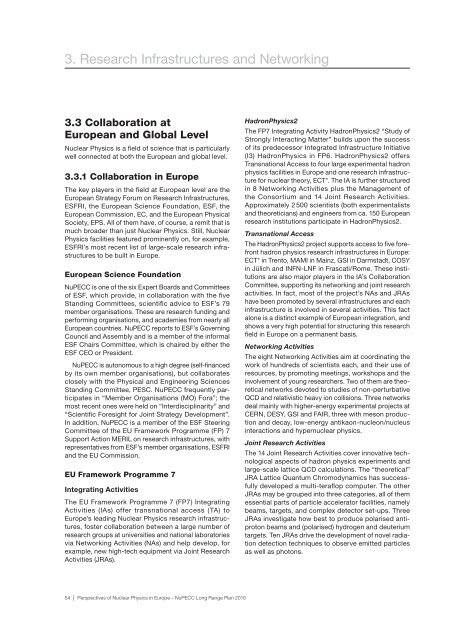Perspectives of Nuclear Physics in Europe - European Science ...
Perspectives of Nuclear Physics in Europe - European Science ...
Perspectives of Nuclear Physics in Europe - European Science ...
Create successful ePaper yourself
Turn your PDF publications into a flip-book with our unique Google optimized e-Paper software.
3. Research Infrastructures and Network<strong>in</strong>g<br />
3.3 Collaboration at<br />
<strong>Europe</strong>an and Global Level<br />
<strong>Nuclear</strong> <strong>Physics</strong> is a field <strong>of</strong> science that is particularly<br />
well connected at both the <strong>Europe</strong>an and global level.<br />
3.3.1 Collaboration <strong>in</strong> <strong>Europe</strong><br />
The key players <strong>in</strong> the field at <strong>Europe</strong>an level are the<br />
<strong>Europe</strong>an Strategy Forum on Research Infrastructures,<br />
ESFRI, the <strong>Europe</strong>an <strong>Science</strong> Foundation, ESF, the<br />
<strong>Europe</strong>an Commission, EC, and the <strong>Europe</strong>an Physical<br />
Society, EPS. All <strong>of</strong> them have, <strong>of</strong> course, a remit that is<br />
much broader than just <strong>Nuclear</strong> <strong>Physics</strong>. Still, <strong>Nuclear</strong><br />
<strong>Physics</strong> facilities featured prom<strong>in</strong>ently on, for example,<br />
ESFRI’s most recent list <strong>of</strong> large-scale research <strong>in</strong>frastructures<br />
to be built <strong>in</strong> <strong>Europe</strong>.<br />
<strong>Europe</strong>an <strong>Science</strong> Foundation<br />
NuPECC is one <strong>of</strong> the six Expert Boards and Committees<br />
<strong>of</strong> ESF, which provide, <strong>in</strong> collaboration with the five<br />
Stand<strong>in</strong>g Committees, scientific advice to ESF’s 79<br />
member organisations. These are research fund<strong>in</strong>g and<br />
perform<strong>in</strong>g organisations, and academies from nearly all<br />
<strong>Europe</strong>an countries. NuPECC reports to ESF’s Govern<strong>in</strong>g<br />
Council and Assembly and is a member <strong>of</strong> the <strong>in</strong>formal<br />
ESF Chairs Committee, which is chaired by either the<br />
ESF CEO or President.<br />
NuPECC is autonomous to a high degree (self-f<strong>in</strong>anced<br />
by its own member organisations), but collaborates<br />
closely with the Physical and Eng<strong>in</strong>eer<strong>in</strong>g <strong>Science</strong>s<br />
Stand<strong>in</strong>g Committee, PESC. NuPECC frequently participates<br />
<strong>in</strong> “Member Organisations (MO) Fora”; the<br />
most recent ones were held on “Interdiscipl<strong>in</strong>arity” and<br />
“Scientific Foresight for Jo<strong>in</strong>t Strategy Development”.<br />
In addition, NuPECC is a member <strong>of</strong> the ESF Steer<strong>in</strong>g<br />
Committee <strong>of</strong> the EU Framework Programme (FP) 7<br />
Support Action MERIL on research <strong>in</strong>frastructures, with<br />
representatives from ESF’s member organisations, ESFRI<br />
and the EU Commission.<br />
EU Framework Programme 7<br />
Integrat<strong>in</strong>g Activities<br />
The EU Framework Programme 7 (FP7) Integrat<strong>in</strong>g<br />
Activities (IAs) <strong>of</strong>fer transnational access (TA) to<br />
<strong>Europe</strong>’s lead<strong>in</strong>g <strong>Nuclear</strong> <strong>Physics</strong> research <strong>in</strong>frastructures,<br />
foster collaboration between a large number <strong>of</strong><br />
research groups at universities and national laboratories<br />
via Network<strong>in</strong>g Activities (NAs) and help develop, for<br />
example, new high-tech equipment via Jo<strong>in</strong>t Research<br />
Activities (JRAs).<br />
Hadron<strong>Physics</strong>2<br />
The FP7 Integrat<strong>in</strong>g Activity Hadron<strong>Physics</strong>2 “Study <strong>of</strong><br />
Strongly Interact<strong>in</strong>g Matter” builds upon the success<br />
<strong>of</strong> its predecessor Integrated Infrastructure Initiative<br />
(I3) Hadron<strong>Physics</strong> <strong>in</strong> FP6. Hadron<strong>Physics</strong>2 <strong>of</strong>fers<br />
Transnational Access to four large experimental hadron<br />
physics facilities <strong>in</strong> <strong>Europe</strong> and one research <strong>in</strong>frastructure<br />
for nuclear theory, ECT*. The IA is further structured<br />
<strong>in</strong> 8 Network<strong>in</strong>g Activities plus the Management <strong>of</strong><br />
the Consortium and 14 Jo<strong>in</strong>t Research Activities.<br />
Approximately 2500 scientists (both experimentalists<br />
and theoreticians) and eng<strong>in</strong>eers from ca. 150 <strong>Europe</strong>an<br />
research <strong>in</strong>stitutions participate <strong>in</strong> Hadron<strong>Physics</strong>2.<br />
Transnational Access<br />
The Hadron<strong>Physics</strong>2 project supports access to five forefront<br />
hadron physics research <strong>in</strong>frastructures <strong>in</strong> <strong>Europe</strong>:<br />
ECT* <strong>in</strong> Trento, MAMI <strong>in</strong> Ma<strong>in</strong>z, GSI <strong>in</strong> Darmstadt, COSY<br />
<strong>in</strong> Jülich and INFN-LNF <strong>in</strong> Frascati/Rome. These <strong>in</strong>stitutions<br />
are also major players <strong>in</strong> the IA’s Collaboration<br />
Committee, support<strong>in</strong>g its network<strong>in</strong>g and jo<strong>in</strong>t research<br />
activities. In fact, most <strong>of</strong> the project’s NAs and JRAs<br />
have been promoted by several <strong>in</strong>frastructures and each<br />
<strong>in</strong>frastructure is <strong>in</strong>volved <strong>in</strong> several activities. This fact<br />
alone is a dist<strong>in</strong>ct example <strong>of</strong> <strong>Europe</strong>an <strong>in</strong>tegration, and<br />
shows a very high potential for structur<strong>in</strong>g this research<br />
field <strong>in</strong> <strong>Europe</strong> on a permanent basis.<br />
Network<strong>in</strong>g Activities<br />
The eight Network<strong>in</strong>g Activities aim at coord<strong>in</strong>at<strong>in</strong>g the<br />
work <strong>of</strong> hundreds <strong>of</strong> scientists each, and their use <strong>of</strong><br />
resources, by promot<strong>in</strong>g meet<strong>in</strong>gs, workshops and the<br />
<strong>in</strong>volvement <strong>of</strong> young researchers. Two <strong>of</strong> them are theoretical<br />
networks devoted to studies <strong>of</strong> non-perturbative<br />
QCD and relativistic heavy ion collisions. Three networks<br />
deal ma<strong>in</strong>ly with higher-energy experimental projects at<br />
CERN, DESY, GSI and FAIR, three with meson production<br />
and decay, low-energy antikaon-nucleon/nucleus<br />
<strong>in</strong>teractions and hypernuclear physics.<br />
Jo<strong>in</strong>t Research Activities<br />
The 14 Jo<strong>in</strong>t Research Activities cover <strong>in</strong>novative technological<br />
aspects <strong>of</strong> hadron physics experiments and<br />
large-scale lattice QCD calculations. The “theoretical”<br />
JRA Lattice Quantum Chromodynamics has successfully<br />
developed a multi-teraflop computer. The other<br />
JRAs may be grouped <strong>in</strong>to three categories, all <strong>of</strong> them<br />
essential parts <strong>of</strong> particle accelerator facilities, namely<br />
beams, targets, and complex detector set-ups. Three<br />
JRAs <strong>in</strong>vestigate how best to produce polarised antiproton<br />
beams and (polarised) hydrogen and deuterium<br />
targets. Ten JRAs drive the development <strong>of</strong> novel radiation<br />
detection techniques to observe emitted particles<br />
as well as photons.<br />
54 | <strong>Perspectives</strong> <strong>of</strong> <strong>Nuclear</strong> <strong>Physics</strong> <strong>in</strong> <strong>Europe</strong> – NuPECC Long Range Plan 2010
















